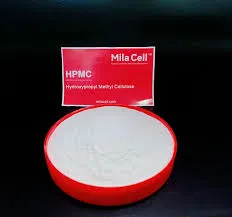
Okt. . 20, 2024 10:14 Back to list
hydroxypropyl methyl cellulose solubility
Exploring the Solubility of Hydroxypropyl Methyl Cellulose Key Properties and Applications
Hydroxypropyl methyl cellulose (HPMC) is a synthetic polymer derived from cellulose, which is a natural polysaccharide found in the cell walls of plants. HPMC is extensively used in various industries, including pharmaceuticals, food, construction, and cosmetics, due to its unique physical and chemical properties. One of the most critical characteristics of HPMC is its solubility, which significantly influences its functionality in these applications.
What is Hydroxypropyl Methyl Cellulose?
HPMC is produced by etherifying cellulose with methyl and hydroxypropyl groups. This modification enhances the solubility of cellulose, which is inherently insoluble in water. The degree of substitution—that is, the ratio of methyl and hydroxypropyl groups to the cellulose chain—plays a crucial role in determining the solubility of HPMC. Typically, higher levels of hydroxypropyl substitution lead to increased water solubility. HPMC is available in various grades, each exhibiting different viscosities and solubility properties, making it versatile for numerous applications.
Solubility Characteristics of HPMC
HPMC is known for its ability to dissolve in cold water, forming a transparent, viscous solution. Unlike many water-soluble polymers, HPMC does not require heating for solubilization, making it particularly useful for processes sensitive to heat. The solubility of HPMC is influenced by several factors, including the molecular weight of the polymer, the degree of substitution, and the temperature of the solvent.
In general, lower molecular weights lead to faster dissolution rates. The viscosity of HPMC solutions is also typically higher with increased concentration. It is important to note that HPMC is not soluble in organic solvents such as chloroform or ethanol, which further emphasizes its unique properties as a cellulose derivative.
Factors Influencing Solubility
1. Temperature The solubility of HPMC increases with temperature. However, since HPMC dissolves in cold water, this property can be advantageous in processes that cannot tolerate high temperatures.
2. Viscosity Grade HPMC is classified into different viscosity grades, ranging from low to high viscosity. Low-viscosity grades dissolve more quickly, while high-viscosity grades may take longer to reach complete solubilization.
hydroxypropyl methyl cellulose solubility

3. Concentration The concentration of HPMC in a solution plays a significant role in its solubility. Higher concentrations can lead to gel formation rather than a clear solution, which is crucial to consider in formulation processes.
4. pH and Ionic Strength The solubility of HPMC can also be affected by the pH of the solution and the presence of electrolytes. Generally, HPMC remains stable across a broad pH range, but ionic strength can influence its solubility and viscosity.
Applications of HPMC Based on Solubility
1. Pharmaceuticals In the pharmaceutical industry, HPMC is widely used as a binder in tablet formulations, providing controlled release of active ingredients. Its solubility properties are essential in ensuring the desired release profiles are achieved in various drug delivery systems.
2. Food Industry HPMC acts as a thickening agent, emulsifier, and stabilizer in food products. Its water solubility allows it to blend seamlessly with other ingredients, enhancing texture and consistency without compromising flavor.
3. Construction In construction, HPMC is employed as an additive in cement and mortar to improve workability, water retention, and adhesion. The solubility of HPMC in water helps in achieving the desired consistency for construction materials.
4. Cosmetics HPMC is used in cosmetic formulations for its emulsifying and thickening properties. Its ability to form clear solutions ensures that cosmetic products maintain an appealing aesthetic.
Conclusion
The solubility of hydroxypropyl methyl cellulose is a fundamental property that underpins its diverse applications across various industries. Understanding the factors that influence HPMC solubility—such as temperature, molecular weight, concentration, and pH—can help in optimizing its use in formulations. As the demand for HPMC continues to grow, ongoing research will likely further enhance its applications, making it an even more invaluable polymer in both traditional and emerging fields.
-
Unlocking the Benefits of HPMC Products: A Gateway to Versatile Applications
NewsAug.07,2025
-
Unleashing the Potential of HPMC Ashland: A Comprehensive Look
NewsAug.07,2025
-
Tile Bonding Cellulose: The Key to Superior Adhesion and Durability
NewsAug.07,2025
-
Hydroxypropyl Methylcellulose Powder: The Versatile Component in Modern Pharmaceuticals
NewsAug.07,2025
-
Hydroxyethyl Cellulose: The Versatile Solution for Various Industries
NewsAug.07,2025
-
Hydroxyethyl Cellulose (HEC): The Versatile Polymer for Various Applications
NewsAug.07,2025







